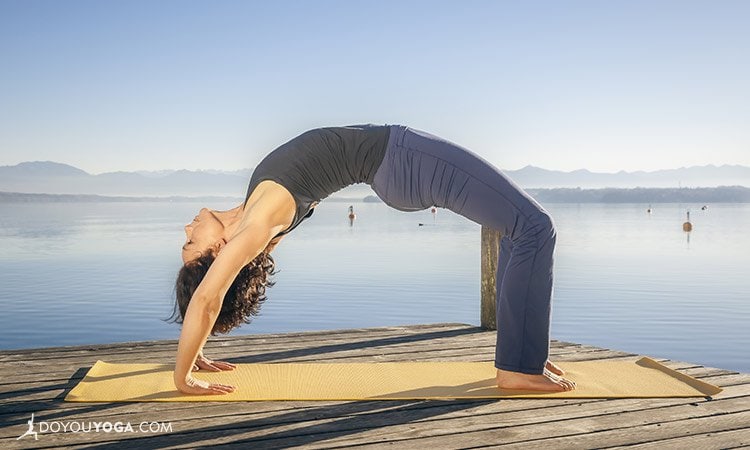I recently had a student ask how to come into Upward Bow (sometimes called “Wheel”) and said she had lower back pain when she tried it. We talked at length about the pose and the key actions involved. So I thought I’d share my tips in case you needed them too. Here are some key actions and tips for Upward Bow:
1. Keep the feet parallel and hip-width distance apart.
When we come into Upward Bow, our hips are moving into extension. This would be the opposite of drawing the knees into the chest or the position of the hips when we’re sitting. We’re essentially “increasing the angle” between the thighs and the belly.
To do this, we need to use our gluteus maximus muscle. This muscle will extend the hip, but it also externally rotates the thighs (as in standing with your feet turned out). If you try to bend your spine, as in a backbend AND turn your toes out, you will increase the pressure at the base of your spine (your sacroiliac joint). This is why students sometimes complain of lower back pain.
Keep the feet parallel to each other when you push up and if they turn out, adjust them back to parallel. A nice trick is to squeeze a block between the thighs as you come up.
2. Push off the legs, not the hands.
While this pose is a combination of hands and feet on the ground, the initial effort should come from the legs. I like to suggest to students “it’s as if you were diving backwards” as a way to bring them into the power of the “push off.” From there, the hands and arms come into play to refine the movement upwards.
3. Wrap the elbows in as you come up.
When coming up into the pose, the elbows must stay in, close to the head. This action is also seen when moving from High to Low Push Up. This will prevent the neck from “scrunching up” and “dumping” into the neck.
As you wrap the elbows in, you activate the serratus anterior muscle, allowing the shoulder blades to stay close to the body and providing the necessary “upward lift” from the floor.
4. Work the bend in the spine from the mid-back (thoracic).
One of the reasons coming into this pose can be toughis that it requires you to bend the mid-back, or thoracic spine. Given the position of the ribs attached to the 12 thoracic vertebra, this is a pretty stiff part of the spine.
I suggest that students set up their hands, wrap their elbows in and then slightly lift their sternum (breastbone). This begins the slight bend in the mid-back and from there, they can come into their legs and press down to lift up.
5. Once you are up in the pose, keep the inner thighs moving down, feet straight and evenly balance between hands and feet.
Just like in many poses that involve the hands and feet on the ground, one of the challenges is to balance out between the two ends of the body. Once you come up into the pose, balance the weight between the hands and the feet. I like to think of the belly button as the “top” of the pose and that part of the body is centered over the floor.
Additional Tips
- Lift the heels. Students will sometimes feel a bit more bend through the spine if they lift their heels once up. Do not lift the toes and push off the heels only.
- Work first onto the crown of the head. For a beginner, coming up onto the crown of the head initially can be a good way to get set up with the key actions: elbows in, bend in the thoracic spine and straighten the feet. Avoid “sinking” into the neck while on the head.
- Build strength by practicing High to Low Push Up. One of the key factors you’ll need for this pose is upper body strength to allow you to lift up. Moving from High to Low Push Up, keeping the elbows wrapped in, will allow you to build the strength to come into Upward Bow.
This pose is sometimes seen as one to conquer. I’ve had students email me in sheer joy when they come into the pose; they feel a sense of accomplishment when they are able to come up into it.
As with all poses, work from the ground up, try not to be too attached to the pose itself and work from strength not from a sense of ego or competition.


